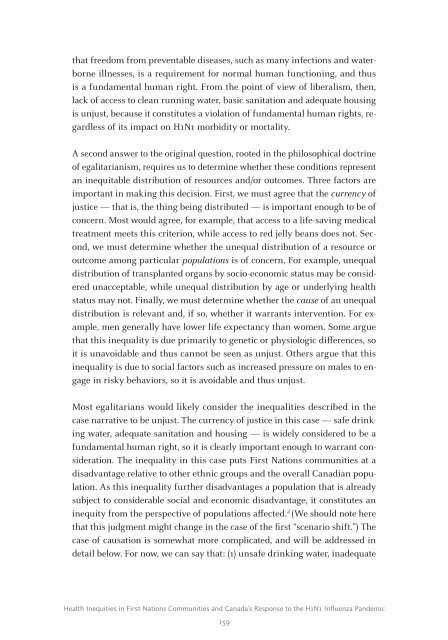PoPulationand Public HealtH etHics
PoPulationand Public HealtH etHics
PoPulationand Public HealtH etHics
Create successful ePaper yourself
Turn your PDF publications into a flip-book with our unique Google optimized e-Paper software.
that freedom from preventable diseases, such as many infections and waterborne<br />
illnesses, is a requirement for normal human functioning, and thus<br />
is a fundamental human right. From the point of view of liberalism, then,<br />
lack of access to clean running water, basic sanitation and adequate housing<br />
is unjust, because it constitutes a violation of fundamental human rights, regardless<br />
of its impact on H1N1 morbidity or mortality.<br />
A second answer to the original question, rooted in the philosophical doctrine<br />
of egalitarianism, requires us to determine whether these conditions represent<br />
an inequitable distribution of resources and/or outcomes. Three factors are<br />
important in making this decision. First, we must agree that the currency of<br />
justice — that is, the thing being distributed — is important enough to be of<br />
concern. Most would agree, for example, that access to a life-saving medical<br />
treatment meets this criterion, while access to red jelly beans does not. Second,<br />
we must determine whether the unequal distribution of a resource or<br />
outcome among particular populations is of concern. For example, unequal<br />
distribution of transplanted organs by socio-economic status may be considered<br />
unacceptable, while unequal distribution by age or underlying health<br />
status may not. Finally, we must determine whether the cause of an unequal<br />
distribution is relevant and, if so, whether it warrants intervention. For example,<br />
men generally have lower life expectancy than women. Some argue<br />
that this inequality is due primarily to genetic or physiologic differences, so<br />
it is unavoidable and thus cannot be seen as unjust. Others argue that this<br />
inequality is due to social factors such as increased pressure on males to engage<br />
in risky behaviors, so it is avoidable and thus unjust.<br />
Most egalitarians would likely consider the inequalities described in the<br />
case narrative to be unjust. The currency of justice in this case — safe drinking<br />
water, adequate sanitation and housing — is widely considered to be a<br />
fundamental human right, so it is clearly important enough to warrant consideration.<br />
The inequality in this case puts First Nations communities at a<br />
disadvantage relative to other ethnic groups and the overall Canadian population.<br />
As this inequality further disadvantages a population that is already<br />
subject to considerable social and economic disadvantage, it constitutes an<br />
inequity from the perspective of populations affected. 2 (We should note here<br />
that this judgment might change in the case of the first “scenario shift.”) The<br />
case of causation is somewhat more complicated, and will be addressed in<br />
detail below. For now, we can say that: (1) unsafe drinking water, inadequate<br />
Health Inequities in First Nations Communities and Canada’s Response to the H1N1 Influenza Pandemic<br />
159
















